Top Smartwatch Apps for iPhone Users in 2023
Intro
With the evolving landscape of technology, smartwatches have become indispensable tools for many iPhone users. These devices not only perform essential functions like telling time and receiving notifications, but also serve as advanced platforms for various apps that enhance our daily lives. The integration of these applications with iPhone devices allows for seamless functionality that promotes productivity, health monitoring, and connectivity.
This comprehensive guide will explore the optimal smartwatch apps specifically tailored for iPhone users, highlighting key features and usability. Each application will be analyzed across categories, such as fitness, communication, and productivity. By examining these elements, readers will gain practical insights into how these applications optimize the smartwatch experience, especially with the latest technological advancements in mind.
In a world increasingly driven by technology, selecting the right apps for your smartwatch can significantly enhance its capabilities. Let's first take a look at the technology behind these devices.
Overview of the Technology
Smartwatches compatible with iPhone operate on a blend of both hardware and software innovations that empower them to deliver a diverse range of functionalities. Understanding the technological foundation can help users appreciate the enhancements that various apps can offer.
Key Specifications
- Operating System: Many top smartwatches, like the Apple Watch, run on watchOS, ensuring smooth integration with iOS devices.
- Battery Life: Depending on the model, battery life can vary significantly, with many devices lasting from several days to a week.
- Sensors: Modern models come equipped with health monitoring sensors such as heart rate monitors, GPS, and accelerometers.
- Connectivity: Most smartwatches support Bluetooth and Wi-Fi, enabling efficient communication with your iPhone.
Unique Selling Points
Smartwatches stand out due to several unique features that make them appealing to iPhone users:
- Customizability: Users can tailor watch faces and notifications to fit their personal style.
- Health Tracking: Integration with health apps allows for comprehensive health management.
- Third-party Apps: A wide range of applications extends the functionality beyond pre-installed software, catering to diverse interests and needs.
"The integration of smartwatch apps with iPhone devices transforms how users interact with technology on a daily basis."
Design and Build Quality
The effectiveness of smartwatch apps is inherently linked to the design and build quality of the devices themselves. A well-designed smartwatch enhances usability, making it easier for users to access the applications they prefer.
Material Used
The materials used in smartwatches vary by model but typically include:
- Aluminum: Lightweight yet durable, often used for mid-range models.
- Stainless Steel: Provides a more premium feel and enhanced durability.
- Ceramic: Known for scratch resistance and a stylish finish, favored in luxury models.
Ergonomics and Usability
Usability is critical for a smartwatch, especially when it comes to app interaction. Factors to consider include:
- Display Size: Larger screens tend to enhance visibility but may affect portability.
- Touch Sensitivity: High-quality touch screens respond accurately to user inputs, improving the overall experience.
- Comfort of Wear: A well-designed wristband and weight distribution contribute to longer wear without discomfort.
Foreword to Smartwatch Applications
The landscape of smartwatches has evolved significantly over the past decade. Today, they act as powerful extensions of smartphones, offering various features that enhance everyday life. Smartwatch applications play a crucial role in unlocking the full potential of these devices, especially for iPhone users. Apps can optimize productivity, assist in health monitoring, and facilitate communication, making them indispensable tools for many.
In this article, we will discuss the benefits of integrating smartwatch apps with iPhone devices. Users can streamline their workflows, monitor health metrics, and receive notifications without reaching for their smartphones. Understanding which apps best fit individual needs is essential in maximizing the smartwatch experience.
The Evolution of Smartwatch Technology
Smartwatch technology began its journey with rudimentary functions. Initially, these devices merely displayed the time and synced with smartphones for notifications. Over time, advancements in hardware and software have facilitated more complex functionalities. Improvements in sensors, processors, and display technology now allow smartwatches to track fitness levels, manage schedules, and execute voice commands.
Wearable technology is constantly in flux. Some of the most striking changes include the introduction of GPS capabilities, heart rate monitoring, and even the integration of biometric data. Major players like Apple, Samsung, and Garmin continuously innovate, ensuring that their smartwatches remain relevant and functional. Each new generation of products tends to offer more specialized apps designed to cater to various niches of users.
Importance of App Compatibility with iPhone
Compatibility between smartwatch applications and iPhone devices is significant for seamless integration and user experience. Many iPhone users expect their devices to work together effortlessly. When an app is designed with iPhone functionality in mind, it ensures that users can readily access features and maintain efficient workflows.
The benefits of app compatibility include:
- Enhanced User Experience: Users benefit from a more cohesive interaction as notifications, messages, and alerts can be synchronized between the devices without disruptions.
- Improved Features: Applications designed specifically for iPhone enhance the functionality of smartwatches, enabling features like touch control and voice commands, making them more effective.
- Smooth Updates: Compatibility ensures that users can easily update apps, receive new features, and access customer support without hassle.
Ultimately, the integration of smartwatch apps with iPhone represents a broader trend towards interconnected devices. As technology grows more sophisticated, the importance of choosing the right compatible applications cannot be overstated.
Criteria for Selecting the Best Smartwatch Apps
Selecting the optimal smartwatch apps is crucial for iPhone users who wish to enhance their experience. The right applications can make the smartwatch a more powerful and versatile tool. When evaluating apps, it is essential to consider three primary criteria: usability and user experience, functionality and features, and battery efficiency and performance. Each of these elements plays a significant role in ensuring that the user gets the maximum benefit from their smartwatch, aligning with their individual needs and lifestyle.
Usability and User Experience
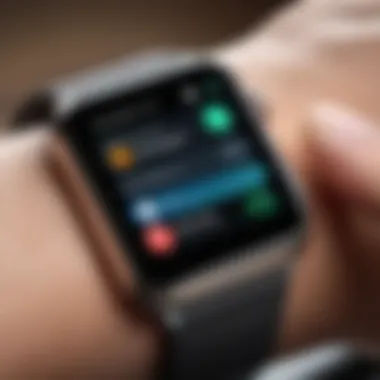
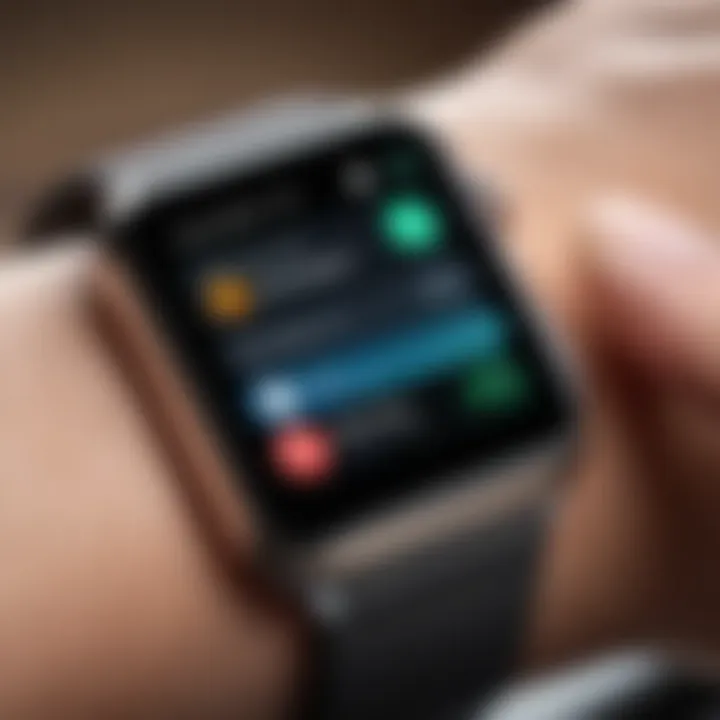
Usability is often the first aspect users encounter when interacting with a smartwatch app. A well-designed application should offer ease of navigation and a user-friendly interface. If an app is difficult to use, it can lead to frustration, negating its intended benefits. Factors such as accessibility, layout, and response time are vital.
Moreover, the user experience extends beyond just usability; it encompasses how well the app integrates with other functions of the smartwatch and the iPhone itself. For instance, notifications should sync seamlessly, allowing users to receive alerts without delay. Ultimately, a positive user experience encourages users to engage with the app more frequently, enhancing its practical value.
Functionality and Features
Functionality is a critical element, as it dictates what users can do with the app. A smartwatch app must meet specific needs while offering relevant features. For fitness tracking apps, look for capabilities like heart rate monitoring, step counters, and workout logging. Communication apps should facilitate messaging and calls directly from the smartwatch.
Additionally, consider the customizability of these features. High-quality apps allow users to tailor settings according to their preferences. For instance, in a productivity app, users might want to prioritize tasks, categorize lists, or set reminders at various intervals. This flexibility contributes to the overall functionality and effectiveness of the application.
Battery Efficiency and Performance
Battery efficiency is an often overlooked but critical factor. A feature-rich app that drains the smartwatch battery quickly can become more of a hindrance than a help. Users need apps that are optimized for performance, ensuring longevity throughout the day. Apps that run in the background and continue to provide valuable data without excessive power consumption are ideal.
Performance also ties into the responsiveness of the app. Slow load times or lagging in updating data can detract from the user experience. It is essential that users assess how well an app performs during real-world usage, as this can vary greatly from the touted capabilities in descriptions.
In summary, the criteria for selecting the best smartwatch apps significantly impact the overall experience for iPhone users. By focusing on usability, functionality, and battery efficiency, individuals can choose apps that not only enhance their productivity but also cater to their specific needs.
Top Smartwatch Apps for Fitness and Health Monitoring
The rise of smartwatches has significantly transformed how we manage our health and fitness. iPhone users in particular benefit from a myriad of applications designed to enhance their health monitoring capabilities. The integration of these apps allows individuals to track key health metrics, set goals, and maintain motivation. These applications are pivotal not only for tracking physical activity but also in fostering a holistic approach to wellness.
Overview of Fitness Tracking Apps
Fitness tracking apps are essential for those who wish to maintain a healthier lifestyle. They promote regular exercise and accountability. Well-known apps like MyFitnessPal and Strava provide users with the tools to log workouts, monitor calorie intake, and analyze performance trends.
Some benefits of fitness tracking apps include:
- Data Collection: Users can gather detailed data on their fitness journeys. Each step taken, each calorie burned, and every minute exercised contributes to a comprehensive health profile.
- Goal Setting: Many of these apps allow users to set personal goals. Whether it's running a certain distance or reaching a specific weight, these targets help to keep users focused.
- Social Features: Many fitness apps offer social components, enabling users to connect with friends and share achievements. This can enhance motivation and create a sense of community.
With numerous options on the market, selecting the right app can be an important decision. Users should consider compatibility, usability, and feature set based on individual needs.
Heart Rate and Activity Monitoring Applications
Monitoring heart rate and overall activity is fundamental for assessing physical health. Applications such as Apple Health and Fitbit offer users the capability to continuously track heart rate variability throughout the day.
Key features include:
- Real-Time Monitoring: Users can view their heart rate in real time, making it easier to stay within target zones. This is especially useful during workouts.
- Trends Analysis: Over time, users can study their heart rate trends. This can help in identifying changes in cardiovascular fitness or in spotting potential health issues.
- Alerts: Many apps provide alerts for abnormal heart rates. This feature can be critical and potentially lifesaving.
Ultimately, heart rate monitoring apps facilitate a deeper understanding of one’s health, enabling informed decisions regarding fitness and lifestyle.
Sleep Tracking and Wellness Apps
Sleep tracking is another vital aspect of health monitoring that often goes unnoticed. Apps designed for sleep analysis, like Sleep Cycle, assist users in understanding their sleep patterns and improve overall wellness.
Here are some important aspects:
- Sleep Quality Monitoring: These apps provide insights into sleep stages, helping users determine how restful their sleep is. Knowing the difference between deep sleep and light sleep can lead to better sleep habits.
- Smart Alarms: Apps can wake users during the light sleep phase, which can lead to feeling more refreshed and less groggy in the morning.
- Wellness Recommendations: Some apps suggest lifestyle changes based on sleep data, such as adjusting bedtime routines or improving the sleep environment.
Incorporating sleep tracking into daily routines can pave the way for more restful nights and enhanced daytime productivity.
"Incorporating technology into fitness and health monitoring can lead to measurable improvements in overall well-being."
By leveraging these fitness and health monitoring applications, iPhone users can cultivate better habits, achieve personal health goals, and ultimately lead healthier lives.
Communication-Focused Smartwatch Apps
Communication-focused apps serve a crucial role in enhancing the functionality of smartwatches for iPhone users. In an age where instant connectivity is paramount, these applications ensure that users stay in touch with their personal and professional networks seamlessly. Such apps are designed to streamline communication, making it easy to receive updates or respond to messages directly from the wrist. The convenience of checking alerts or engaging in conversations without reaching for the phone provides a tangible benefit in terms of efficiency and accessibility.
Moreover, these applications often integrate with various services, allowing users to manage alerts, calls, and messages within a single interface. This integration not only offers a more organized approach to communication but also aligns well with the overall user experience of the smartwatch. As smartwatches continue to evolve, the emphasis on communication remains essential for user satisfaction and overall device functionality.
Messaging Platforms Compatible with iPhone
Messaging apps that are compatible with iPhone offer several advantages for smartwatch users. These platforms often include popular options such as WhatsApp, Telegram, and Facebook Messenger. Each of these applications brings unique features that enhance communication convenience.
- Instant Notifications: Users benefit from real-time alerts on their smartwatches. This means they do not miss important messages even when their phones are out of reach.
- Quick Replies: Many messaging applications allow users to respond quickly using pre-set responses or voice commands. This is particularly useful for busy professionals who need to maintain communication without lengthy interruptions.
- Voice Messages: Some apps provide the option to send voice messages. This feature is ideal for situations where typing is impractical.
With a user-friendly interface designed for small screens, these messaging platforms ensure that communication remains fluid and uncomplicated. The ability to access chats, send messages, or even make calls directly from the watch emphasizes the blend of utility and technology that smartwatches strive to provide.
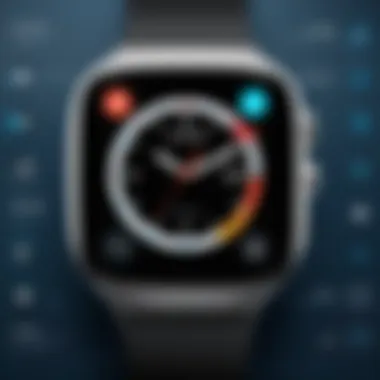
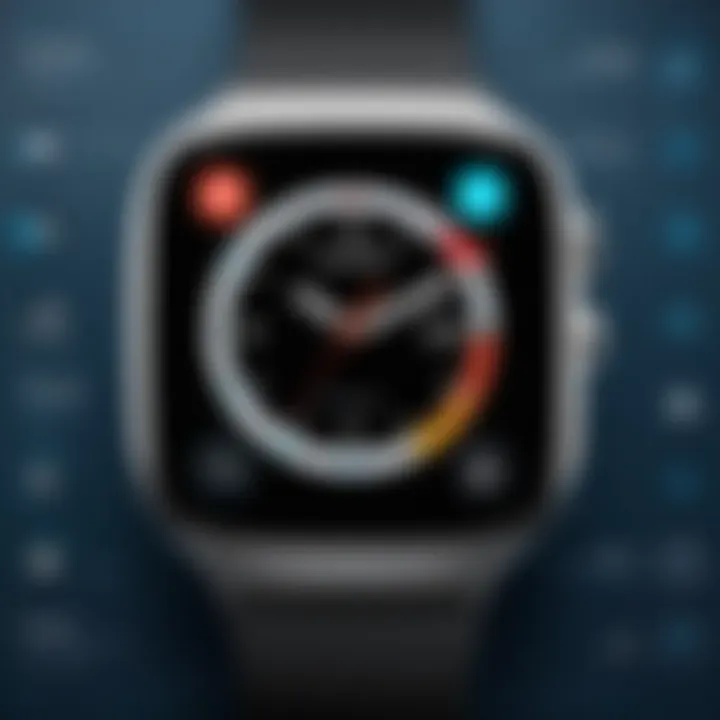
Voice Assistant Capabilities
Voice assistant features have become a core aspect of communication-focused apps for smartwatches. The integration of virtual assistants like Siri enhances the functionality of iPhone-compatible smartwatches. Users can activate voice commands to perform various tasks, including making calls, sending messages, or searching for information without the need for physical interaction.
- Hands-Free Operation: Voice assistants allow for hands-free communication, which is especially beneficial in situations where users may be occupied or unable to use their hands.
- Task Management: Users can quickly set reminders, schedule appointments, or even check their calendar through voice commands. This supports a more organized and efficient day-to-day workflow.
- Contextual Awareness: Many modern voice assistants learn from user behavior. They become increasingly efficient at understanding commands, which simplifies interactions over time.
"Voice assistants empower smartwatch users to multitask efficiently, maintaining essential communications while juggling other responsibilities."
Productivity Applications for Busy Professionals
In today’s fast-paced world, efficiency is a crucial consideration for professionals. Productivity applications play a fundamental role in optimizing daily workflows. Smartwatches, coupled with iPhone integration, have transformed how busy individuals manage their tasks. These applications simplify numerous day-to-day activities, allowing users to maintain focus while enhancing time management.
The benefits of productivity applications are manifold. They allow users to create and manage tasks on a small screen, a helpful feature when time is precious. Notifications can serve as reminders, ensuring no deadline is overlooked. Furthermore, many of these applications sync with other devices, facilitating seamless transitions between workstations. With features tailored for the mobile experience, users can access important information at a glance, whether they are in a meeting or commuting.
When selecting a productivity application, it is critical to consider usability and compatibility. The interface must be intuitive and efficient, allowing users to navigate quickly with their smartwatch. Also, ensuring that the app works well with the iPhone is paramount for a smooth experience. In this section, we explore tools focusing on task management and calendar scheduling, both essential components of productivity.
Task Management and To-Do Lists
Task management applications are integral for structure in a busy professional's life. They help categorize tasks efficiently, allowing for prioritization based on urgency and importance. Users can break larger projects into manageable steps, making daunting tasks less overwhelming.
Some notable task management apps include:
- Todoist: Offers a powerful task-interface that integrates with multiple platforms.
- Microsoft To Do: Syncs with Outlook and simple in design, focusing on the user’s productivity.
- Asana: Excellent for team collaboration, it provides features that allow for project tracking.
The effectiveness of these tools often lies in their reminder systems. Notifications can alert users to project updates or deadlines. This feature is particularly useful when multitasking or engaging in varied projects.
Calendar and Scheduling Applications
Calendar applications are essential for organizing meetings, appointments, and personal commitments. A well-managed calendar can greatly minimize scheduling conflicts and enable better time allocation. Using these applications on a smartwatch can enhance accessibility to schedules, making it easier to check conflicts or adjust plans promptly.
Popular calendar apps include:
- Google Calendar: Renowned for its sharing capabilities and sync options across devices.
- Apple Calendar: Integrated into iOS, offering smooth synchronization for iPhone users.
- Outlook Calendar: Favored by professionals for its embedded email application features.
Integration with smartwatches allows for actionable notifications and quick responses to meeting requests. Users can accept or decline invitations directly from their wrist, eliminating the need to pull out a phone frequently.
In summary, productivity applications fundamentally enhance effectiveness for professionals. By focusing on task management and calendar scheduling, users can maximize their smartwatch's capabilities, paving the way for an efficient work-life balance.
Integrating Smartwatch Apps with Lifestyle Management
The coordination between smartwatch applications and lifestyle management plays a crucial role in enhancing daily efficiency and comfort. As individuals strive for balance in their lives, the integration of technology becomes essential. Smartwatches can support various lifestyle aspects through specialized apps that facilitate organization, financial management, and travel assistance.
The convenience offered by these apps is significant. Smartwatches provide instant notifications that keep users informed and connected without the need to pull out their phones. This seamless connection is critical for people balancing work, fitness routines, and personal time. With the right apps on their smartwatches, iPhone users can manage and optimize their daily activities effectively.
Moreover, lifestyle management through smartwatch applications emphasizes a proactive approach to personal productivity. The ability to access information and tools at a glance empowers users to make informed decisions swiftly. Such accessibility encourages better planning and resource allocation, which is essential in today’s fast-paced environment.
Travel and Navigation Tools
Traveling can be stressful, and having effective navigation tools on a smartwatch simplifies the entire process. Smartwatch apps like Google Maps or Apple Maps not only provide directions but also allow users to view the projected time of arrival and avoid traffic simultaneously. With turn-by-turn navigation directly on the wrist, travelers can concentrate on the road without constant distractions from their phones.
Additionally, airlines often have dedicated apps that offer functionality like boarding pass storage. This means travelers can check in, access flight information, and stay updated on delays—all from their smartwatches. Therefore, relying on these tools makes travel easier, more efficient, and enhances the overall experience.
Finance and Budgeting Apps
Financial planning has become more manageable with apps tailored for smartwatches. Tools like Mint and PocketGuard allow users to keep an eye on their budgets in real time. With a few taps on their wrist, individuals can track spending, categorize transactions, and receive alerts for unusual transactions.
The ability to monitor finances instantly contributes significantly to better money management. Users can set financial goals and get reminders directly to their smartwatches, which encourages adherence to budgeting plans. This functionality is essential in an age where continuous oversight of personal finances is increasingly necessary for economic stability.
In summary, integrating smartwatch applications into lifestyle management offers several key benefits:
- Enhanced organization and productivity
- Immediate access to travel aids
- Real-time financial monitoring
"Keeping various aspects of life organized through technology is not just a trend, it's a necessity for personal and professional growth."
By utilizing smartwatches coupled with specific applications, iPhone users can create a streamlined lifestyle, resulting in greater efficiency and less stress.
Customization and Personalization Options
Customization and personalization are essential elements when considering smartwatch applications. These features allow users to tailor their devices to align with their individual preferences and needs. The ability to modify various aspects of a smartwatch not only enhances user experience but also fosters a deeper connection between the user and the device.
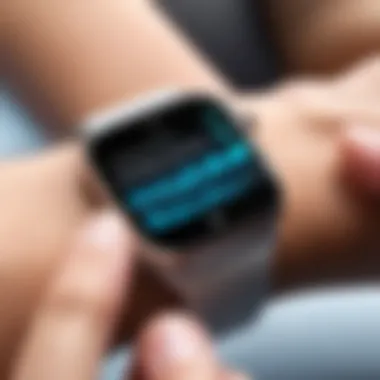
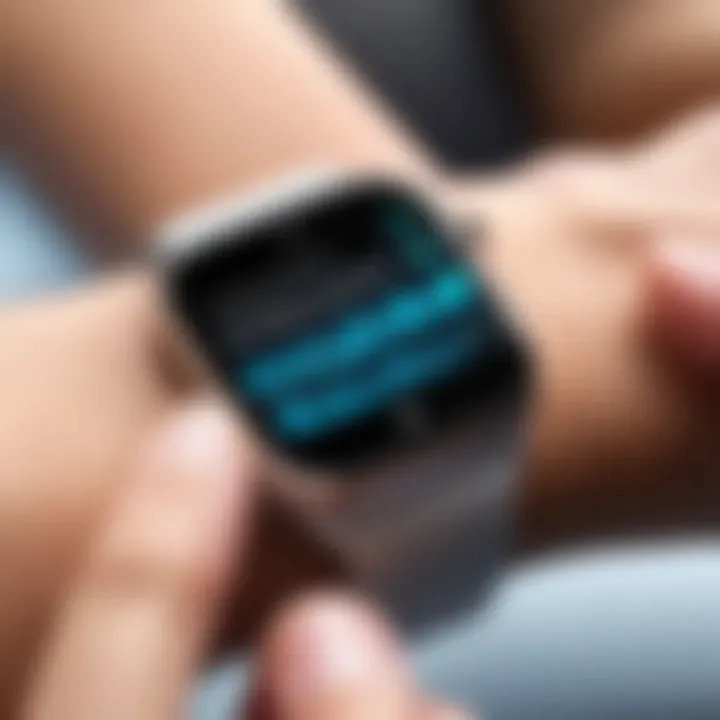
For iPhone users, customizing their smartwatch enables an interface that resonates with their personal style and habits. This uniqueness contributes to a more enjoyable experience, as users can interact with a device that feels more like an extension of themselves.
Additionally, personalization can improve functionality. Users can prioritize the apps and notifications that are most relevant to them, leading to increased efficiency in daily tasks. Since each person's lifestyle varies, having the ability to customize means better usability and performance tailored to individual needs.
Watch Faces and Themes
The watch face is often the first point of interaction a user has with their smartwatch. A customizable watch face allows individuals to display essential information at a glance, such as time, date, and notifications. Many smartwatches now offer a variety of themes and designs. Users can choose from minimalist styles or more vibrant, artistic displays according to their mood or occasion.
For instance, users might opt for an analog face during formal settings, while a digital face with bright colors might suit a casual outing. The options can include different layouts, colors, and complications.
- Benefits of Custom Watch Faces:
- Provides quick access to important information.
- Reflects personal style.
- Encourages engagement with the device.
Application Settings and Notifications
Personalizing application settings and notifications is another critical aspect of optimizing a smartwatch. Users can configure notifications based on priority, ensuring that alerts for essential apps like messaging or calendar take precedence over less important ones.
Users also have the option to adjust the frequency of notifications, which can help to reduce distractions throughout the day. Understanding these settings can transform how a user interacts with their smartwatch, leading to a more functional tool in their daily life.
- Considerations for Notification Settings:
- Determine which apps are most important for immediate alerts.
- Choose quiet hours to limit disruptions.
- Utilize vibration settings for discreet notifications.
In summary, the significance of customization and personalization stretches beyond aesthetic appeal. It impacts usability and productivity, ensuring that each user can shape their smartwatch experience in a way that fits seamlessly into their life.
Future Trends in Smartwatch Apps
Understanding the future trends in smartwatch applications is crucial for both developers and users. As technology evolves, user needs adapt alongside it. The way applications function and interact with iPhone devices significantly influences user experience, efficiency, and overall satisfaction. This section will explore emerging technologies that are reshaping the smartwatch app landscape and predict how user preferences will shift in response.
Emerging Technologies Impacting App Development
New technologies are continuously emerging, affecting how smartwatch apps are developed and used. For instance, Artificial Intelligence (AI) is increasingly integrated, allowing apps to provide personalized recommendations. Profound machine learning algorithms can analyze user behavior, adapting features to fit individual preferences. This capability enhances usability, giving users tailored experiences based on their habits and needs.
Wearable Integration is another critical aspect. As the ecosystem of smart devices grows, there is a strong focus on seamless interaction between wearables and other gadgets like home automation systems. Integration with voice assistants like Siri facilitates control over a variety of tasks, making the smartwatch an essential tool rather than just an accessory.
Furthermore, advancements in health monitoring technologies have inspired many app developers to prioritize features that monitor a user’s well-being. For example, the integration of more sophisticated biometric sensors can provide deeper insights into health metrics, influencing how applications present data to users. This not only targets a health-conscious audience but also broadens the market for smartwatch applications.
- AI for personalization
- Wearable technology integration
- Advanced health monitoring
These innovations will not only impact how existing applications function but also create opportunities for entirely new applications as technology progresses.
Predicted Changes in User Preferences
User preferences for smartwatch applications are likely to evolve in several predictable ways. As awareness of health and fitness continues to rise, many users will seek applications that prioritize health tracking and wellness. Demand for apps that seamlessly integrate health features with lifestyle management tools will likely surge.
Users will also become more inclined towards applications offering enhanced governance of their data. With growing privacy concerns, more people will prefer applications that ensure robust data protection and transparent policies regarding user data usage. This trend will push developers to prioritize security in their offerings.
The demand for customization will also grow. More users will want the ability to personalize their smartwatch interfaces, ensuring their gadgets reflect individual styles and preferences. Applications that allow extensive customization options could have a competitive edge in attracting a diverse user base.
"The shift towards personalization and data privacy will shape the next generation of smartwatch apps."
In summary, these projected changes highlight the importance of thoughtful app development in responding to user needs. Adapting to trends and preferences can not only enhance user satisfaction but also drive the growth of the smartwatch ecosystem.
Epilogue
In the rapidly changing landscape of technology, the integration of smartwatch applications with iPhone devices is paramount. This article provides an encompassing view of the optimal smartwatch apps available for iPhone users, illuminating their diverse functionalities, benefits, and usability. The use of these applications not only enhances productivity but also supports health monitoring and improves connectivity. When considering the overall experience, engaging with the right applications can lead to smoother daily routines and more organized lives.
Smartwatch apps enable users to streamline notifications, track fitness metrics, manage personal tasks, and more, creating a convergence of convenience and innovation. The increasing reliance on technology for personal and professional tasks underscores the necessity of choosing well-designed apps that complement the iPhone ecosystem. Crucially, understanding how these apps function and their compatibility with the iPhone can empower users to make informed decisions.
Investing time in selecting the right smartwatch applications can enhance both productivity and personal well-being.
Overall, recognizing the key elements of app selection — including usability, functionality, compatibility, and performance — allows users to leverage their smartwatches more effectively. As technology continues to advance, the apps discussed in this article represent a snapshot of current best practices designed to meet the needs of tech-savvy individuals and gadget lovers.
Summary of Key Takeaways
- Smartwatch apps are essential tools for enhancing productivity and improving health monitoring.
- Selecting compatible apps that work efficiently with iPhones is crucial for optimizing the smartwatch experience.
- The main factors for choosing apps include usability, functionality, battery efficiency, and user experience.
- Users should focus on apps that offer the features most relevant to their individual lifestyle needs, whether it is fitness tracking, productivity enhancements, or communication tools.
Final Recommendations for iPhone Users
To maximize the benefits of smartwatch applications, here are recommendations for iPhone users:
- Prioritize apps that integrate seamlessly with iOS to enhance overall functionality. Applications such as Apple Health, Strava, and Todoist stand out as top choices.
- Consider personal health and fitness goals when selecting tracking applications, ensuring they offer the necessary features for progress monitoring.
- Explore communication apps that allow for efficient message management and notifications. Options like WhatsApp and Telegram provide robust solutions for staying connected.
- Regularly update the apps to ensure access to the latest features and improvements in performance.
- Take advantage of customization options in watch faces and notifications to create a personalized user experience that fits one’s lifestyle.
By thoughtfully choosing and utilizing these smartwatch applications, iPhone users can elevate their daily routines, improve their time management, and maintain a balanced lifestyle.







